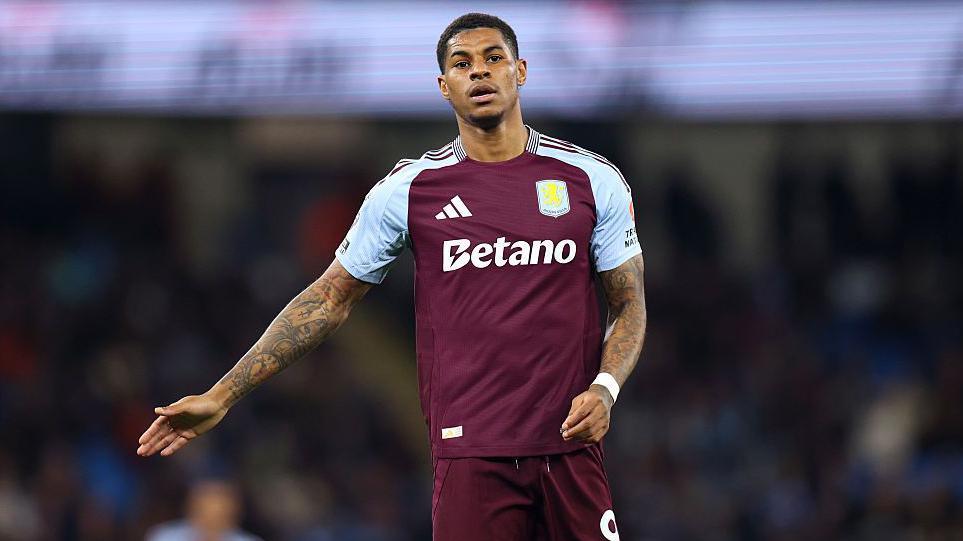Are hamstring injuries getting worse in the Premier League?

Marcus Rashford will miss the season with a hamstring injury
- Published
The rate of hamstring injuries in the Premier League is set to decrease this season compared to the 2023/24 campaign, although data shows players are being ruled out for longer.
Marcus Rashford's injury is the 124th of its kind this season.
With an average of four hamstring injuries recorded every game week - and with four weekends of the season left - this total could rise to 140.
This trails last season's total of 163.
2024-25: 124 hamstring injuries (as of 28th April)
2023-24: 163
2022-23: 138
2021-22: 129
2020-21: 122
Ben Dinnery, injury analyst and founder of Premier Injuries Ltd, believes the data shows an overall 'static' trend of muscle injuries - specifically hamstrings - in recent years, although the severity of hamstring injuries appears to be getting worse, with players being kept out for longer.
In 2023-24, more than half (52%) of hamstring-related injuries kept players sidelined long term, for more than 30 days.
In the 2022-23 and 2020-21 seasons, these figures were 46% and 30%, respectively.
As of 28 April 2025, 61 per cent of Premier League players are suffering hamstring injuries at present, that take them out for more than 30 days.
Arsenal duo Bukayo Saka and Kai Havertz, and Chelsea striker Nicholas Jackson are three high-profile players who have experienced 'long-term' hamstring injuries this season.
What causes hamstring injuries?
The hamstring is a group of three muscles that run from the bottom of your pelvis to the back of your knee.
These muscles work together to flex the knee joint - bringing your thigh backwards or heel to your bottom - and to stabilise the hip.
These are fundamental movements to the running motion, particularly speeding up and slowing down.
Injuries occur when the muscles are overstretched, and tear. This can happen both within the hamstring muscles and the tendons, the tissues that connect muscles to bone.
Nick Worth - sports performance physiotherapist who has worked with multiple Premier League clubs, including Manchester City and Fulham - says that one of the biggest indicators of a hamstring problem is having a previous hamstring injury.
Footballers are repeatedly making explosive movements, such as sprinting and stopping at high speeds, which puts high stress on the hamstrings.
This, on top of the cumulative effect of games with not much gap in between, can cause muscles to fatigue, stiffen, and tear.
Why are players being kept out for longer with hamstring injuries?
It is impossible to pinpoint a single factor.
Worth says that the first thing to look at is the player's individual rehab programme.
The risk of re-injuring the hamstring goes down if you 'over-rehab' players and keep them out of the squad for longer.
The speed of return will also depend on the type of injury, with tendon-based hamstring injuries taking longer to heal.
Last year, player unions and leagues accused Fifa of abusing its role when it comes to the international football calendar, and the number of games players face in a season.
"Fatigue means that the hamstring muscles are 'stiffer' and less able to perform at high speed or power - especially when accelerating and decelerating quickly", Worth added.
- Published1 day ago
- Published8 January
Playing a high pressing game could expose players to risk factors associated with hamstring injuries.
Worth said: "When players are expected to close down opposition, winning a ball back at high speed, players will be doing more acceleration and deceleration and that can increase the risk".
Hamstring injury risk may also be greater for some positions. For example, you would expect a wing-back to perform more explosive sprints in a game than a centre-back, placing a higher workload on the hamstrings.
This article is the latest from BBC Sport's Ask Me Anything team.
More questions answered...
What questions would you ask?
We're looking for your questions for the Ask Me Anything team. Post them in the comments section and we'll look to answer the best of them in the future.